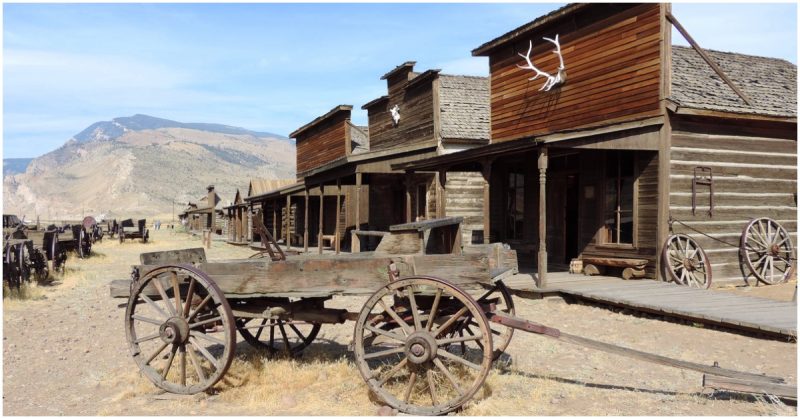When we read about the American West and the taming of this wild frontier we tend to focus on cowboys, outlaws, stagecoaches and the Pony Express, we tend to forget that without the thousands of ordinary families that braved this wild territory, the West might never have been settled.
The families that struggled to carve a living out of the wilderness needed tools to help them, and it is fascinating to look back at the ordinary day-to-day items that made such an essential difference to the lives of settlers.
Conestoga Wagon or Prairie Schooner Wagon
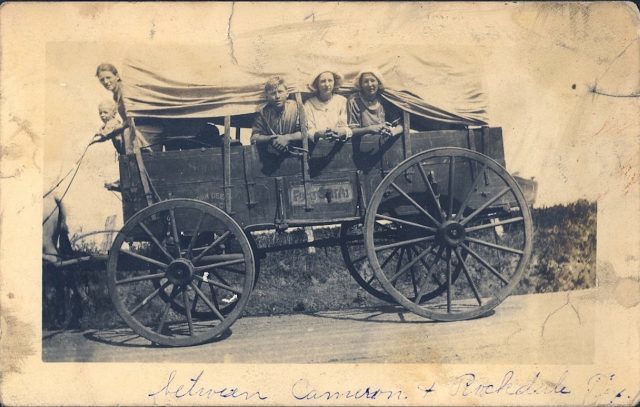
The most famous of the wagons that traipsed across America was the Conestoga wagon. This heavy-duty, four-wheeled, wood and canvas covered wagon was made in the area around the Conestoga River in Pennsylvania.
The Prairie Schooner was the same type of wagon, just not made in Pennsylvania. Wagons were drawn by oxen, mules or horses and were the home for thousands of families that trailed across America.
The wagon could carry a load of around 6 tons, and the family would take everything that they needed for their new home: tools, furniture, household goods, food, and clothing.
As the wagons and their wheels were made of wood, they required a great deal of maintenance on the trail. The dry atmosphere sucked moisture from the wood and caused it to shrink, making for all kinds of difficulties.
Wheelwrights became sought after men, as strong, well-made wheels were an absolute must. Regular greasing was also required, and initially, animal fat was used, but this was in such short supply greasing was infrequently done.
There are several accounts of bacon being cut up and wrapped around spindles to provide grease. Linseed oil and a tub large enough to hold a wheel were carried so that the oil could be warmed as this allowed it to soak into the wood much faster.
Most important of the wagon tools was the jack, with many having the reputation for being ‘finger-mashers’. Most jacks were robust and simple in construction as they had to raise a laden wagon, which was no easy task.
Once the family arrived and had staked their farm (known as homesteading), there was a great deal more hard work to be undertaken. The first thing to do was build a cabin for themselves and a barn as protection for animals.
Housing
Settlers that homesteaded on the prairie had very little in the way of building material as trees were few and far between. They did have the prairie grass that grew with a very dense root conformation, so they cut blocks of this sod and piled them up to make walls. These sod houses were damp but had good insulation properties. They were also susceptible to damage by rain and snow, so they needed regular maintenance.
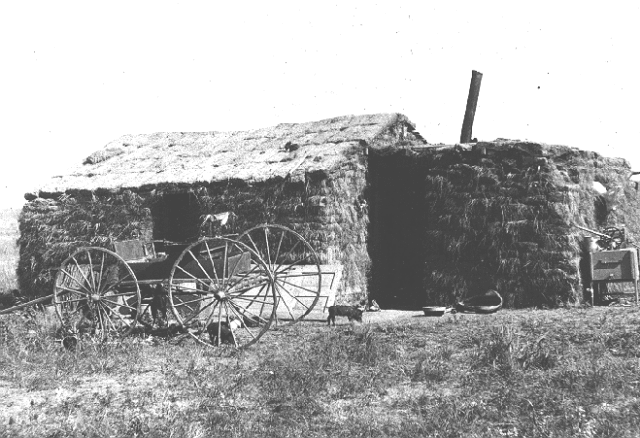
Once a house had been established, all the male members of the household started creating a farm out of the wilderness, whilst the female members looked after the house, kitchen garden, and small animals, as well as helping out in the fields when needed.
Ploughs
In the early days, everything was done by hand, including plowing, reaping, and winnowing. It is estimated that it took 250-300 man hours to produce 100 bushels of grain (around 5 acres in size). By mid-1800 wooden plows were available, faced with metal saw blades to try and improve longevity, and eventually in 1837, John Deere manufactured the first all steel plow. Steel had to be imported from England, so it was rare and expensive.
Once the grain was brought in from the field, it had to be threshed to separate the grain from the stalk. Flails were used for this, and one man could thresh seven bushels of wheat a day. It was not until the mid-1800’s that any kind of threshing machine made an appearance.
This reaper, invented by Cyrus H. McCormick, was a significant step forward in the production of grain as it made the reaping so much faster and less labor intensive. The principles of the modern reaping equipment are based upon this simple machine.
By the 1850s, every farmer would have coveted this piece of equipment designed to winnow grain; separating the grain from the chaff.
By the late 1800s, the windmill, or rather wind-pump, had made its appearance, making the task of pumping water infinitely easier. Gone was the old well with its bucket and in its place was an efficient wind driven pump.
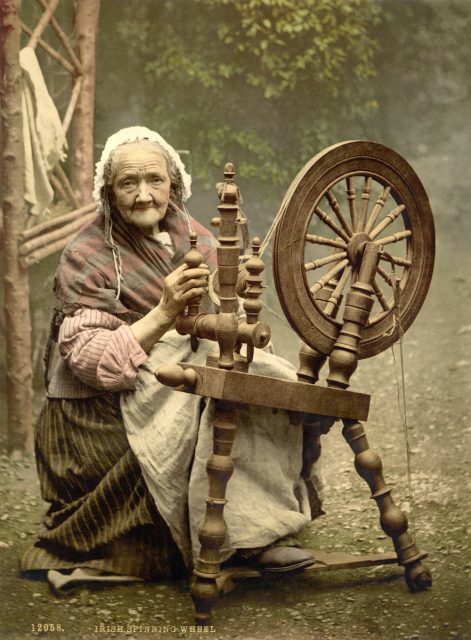
Many frontier families lived many miles from the nearest town and cloth was often hard to come by. This means that many pioneer women relied on their trusty spinning wheel to spin wool into thread. This wool was then dyed using natural dyes, most probably in shades of brown and gray, and then the cloth was woven from the dyed thread.
Once the cloth was ready, it would be sewn into garments for all the family, thus giving rise to the term ‘homespun clothing’. This term was used to identify the rougher quality of cloth produced by ladies at home versus the finer cloth produced by machinery and imported into America from Britain.
Cast Iron Stoves and Cookware
The cast iron stove was used by almost every kitchen in the west. These stoves were manufactured in America and shipped west. Women had a tough time using these stoves.
They burned wood, or if there was none, corn cobs or dried animal droppings.
The stoves smoked and spewed soot which meant that the room had to be cleaned every day after cooking. Also, the cast iron would rust if it was not treated with stove black, a type of wax.
Ivory Soap
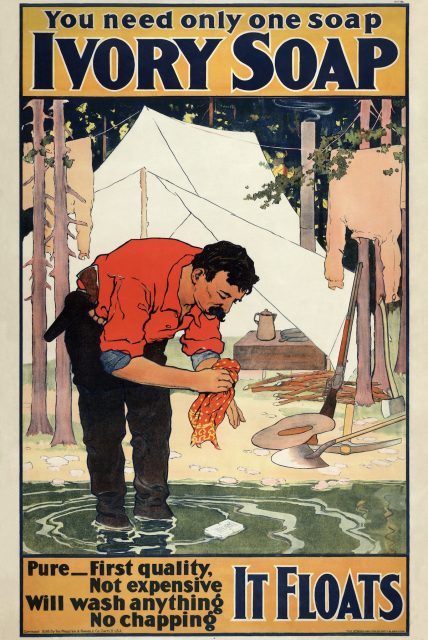
James Gamble, the son of the company’s co-founder, came across the secret and made a note of it in his notebook in 1863 but it was not until 1979 that floating soap was marketed to the nation.
This soap was a boon to the frontier families as most of their bathing was done in rivers and streams and soap that floated was a great help.
Edged tools
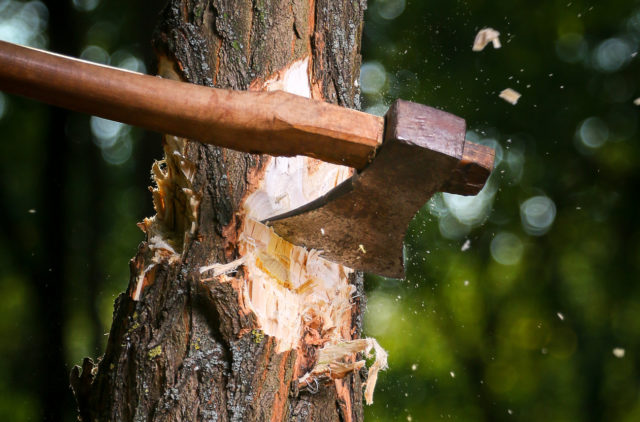
Good quality knives were invaluable to the frontier families. In the early 1800s, knives made in Sheffield, England, were imported into America and were preferred over the locally made product. Knives made by blacksmiths were not popular as the quality varied so greatly that they could not be trusted.
All families had a range of knives for basic domestic use, which included cleavers, skinning knives and paring knives. The first good quality knives manufactured in America came from J. Russell & Company.
Most frontiersmen carried a strong knife all the time. The blade was used for not only domestic use but was also for protection against all manner of threats.
The most famous of these knives was the Bowie Knife, made originally by a blacksmith from Arkansas, Jim Black, for Jim Bowie.
Every farmer owned several axes, used for chopping wood and building homes and fences. The axes were rather crude in nature but did the job very efficiently.
Money Belts
Traveling in the West was fraught with dangers, from highwaymen to poor roads that caused many accidents. To protect their hard earned money from highwaymen, many people wore a money belt. The vest has pockets that carried the money safely buttoned up.
Weapons
Every frontier family owned at least a handgun and if they could afford it, a rifle. Every member of the family was taught to shoot as there were plenty of threats that needed to be overcome. Venomous snakes, wolves, cougars, and bears roamed the countryside, and then there were the human predators that roamed the west at will, Gizmodo reported.
The romantic image of the wagon trains and the settlers is just that; a romantic image.
These hardy folk had to contend with many hardships, both natural and manmade, with few luxuries available. Medical care was rudimentary, and the farmer’s wife would grow a patch of herbs that could be used to treat everyday ailments.
Serious injuries often resulted in death as there was no medical care and childbirth was hazardous in the extreme. These hardy pioneers developed the west into the country that we know today, with the most rudimentary of tools to help them on their way.
